We are supported by our audience. When you purchase through links on our site, we may earn an affiliate commission, at no extra cost for you. Learn more. Last update on 30th June 2025 / Images from Amazon Product Advertising API.
I’ve tested dozens of nylon filaments and found YXPOLYER Nylon PA6 delivers exceptional 381°F heat resistance with 10x PLA’s toughness, while Polymaker Fiberon PA612-CF offers superior tensile strength through carbon fiber reinforcement. OVERTURE Nylon prints like PLA but maintains engineering-grade durability, and SUNLU Easy PA provides excellent abrasion resistance up to 121°C. FLASHFORGE PLA Flexible stretches four times its length for flexible applications. Each requires specific temperature control and moisture management for ideal results, with detailed printing parameters determining your project’s success.
Notable Insights
- YXPOLYER Nylon PA6 offers 10x toughness of PLA with excellent fatigue resistance for automotive and industrial applications.
- Polymaker Fiberon PA612-CF combines carbon fiber reinforcement with lower moisture sensitivity and minimal warping for precision parts.
- OVERTURE Nylon provides engineering-grade strength with PLA-like printing simplicity, though limited in color options and higher cost.
- SUNLU Easy PA delivers high mechanical strength and heat resistance up to 121°C, ideal for functional prototypes requiring durability.
- FLASHFORGE PLA Flexible stretches up to four times with high elasticity, perfect for phone cases and flexible applications.
3D Printer Filament Nylon PA6 1.75mm (Black)
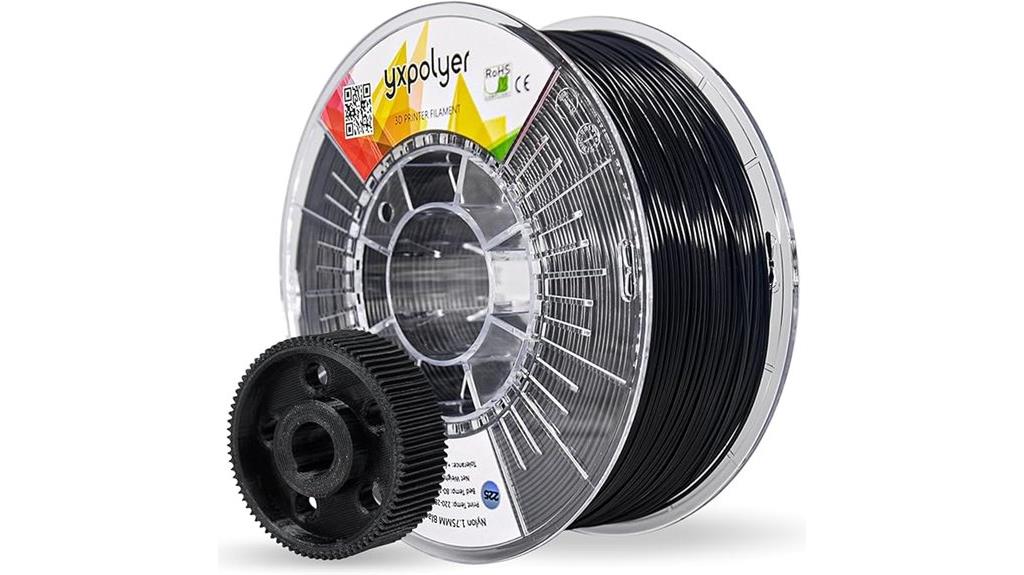
YXPOLYER’s nylon PA6 filament delivers ten times the toughness of standard PLA, making it the ideal choice for engineers and makers who need durable parts that withstand mechanical stress and repeated use. This 1.75mm black filament weighs 1kg and melts at 381°F, requiring specific printing conditions for best possible results.
You’ll need to print at 280°C without cooling fans and use slow speeds for proper layer adhesion. The material excels in automotive and industrial applications due to its superior heat resistance and low friction coefficient. However, warping presents challenges with larger prints despite heated chambers. Using 40-80% gyroid infill maximizes impact resistance, while glass build plates improve adhesion for better results.
Best For: Engineers, makers, and professionals who need extremely durable 3D printed parts for automotive, industrial, or mechanical applications that require high toughness, heat resistance, and fatigue resistance.
Pros:
- Exceptional durability with 10x the toughness of PLA and superior fatigue resistance for parts under cyclic loading
- Outstanding heat and chemical resistance with low friction coefficient, making it ideal for automotive and industrial applications
- Excellent layer adhesion and structural integrity when printed with proper settings, producing factory injection molded quality results
Cons:
- Significant warping issues especially with larger or thicker parts, even when using heated chambers
- Requires specific and challenging printing conditions including 280°C temperatures, no cooling fans, and extensive experimentation to achieve optimal results
- Prone to stringing issues and requires proper drying techniques and specialized equipment like glass build plates for best adhesion
FLASHFORGE PLA Flexible 3D Printer Filament 1.75mm (1Kg Spool)
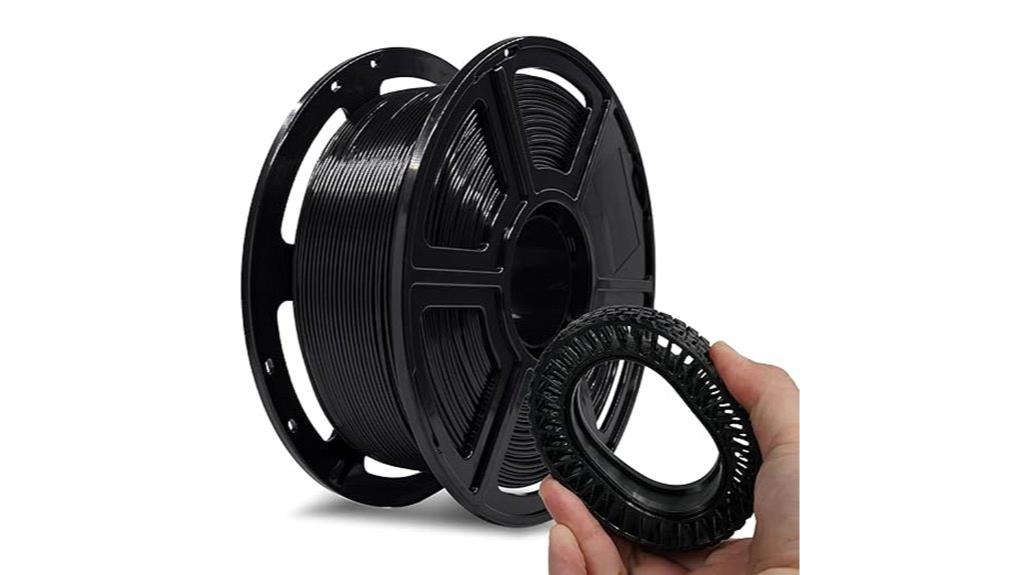
FLASHFORGE’s PLA Flexible filament delivers exceptional elasticity for creators who need materials that bend without breaking. This 1.75mm filament stretches up to four times its original length while maintaining dimensional accuracy of +/- 0.02mm. You’ll find it ideal for phone cases, insoles, and decorative projects requiring flexibility.
The filament works with both Bowden and direct drive extruders, though Bowden setups may need adjustments. Print at 220°C nozzle temperature and 60°C bed temperature. Use 40mm/s speeds for best results. You won’t need special nozzles or heated beds typically.
FLASHFORGE vacuum-seals each spool after 24-hour drying. However, the material absorbs moisture readily, so you’ll want a filament dryer for consistent performance.
Best For: Creators and DIY enthusiasts who need flexible 3D printing material for projects like phone cases, insoles, belts, and decorative items that require elasticity and bend resistance.
Pros:
- Exceptional elasticity that stretches up to four times original length while maintaining precise dimensional accuracy of +/- 0.02mm
- Easy to print compared to TPU with no special nozzles or heated bed typically required, compatible with both Bowden and direct drive extruders
- Well-packaged with vacuum sealing and 24-hour pre-drying, available in seven color options at reasonable value
Cons:
- Absorbs moisture easily requiring a filament dryer for consistent performance and print quality
- Mixed user experiences with issues including clogging, print surface adhesion problems, and variable success rates
- Bowden extruder setups may require adjustments and fine-tuning to achieve optimal results
Polymaker Fiberon PA612-CF Carbon Fiber Nylon 3D Printing Filament 1.75mm
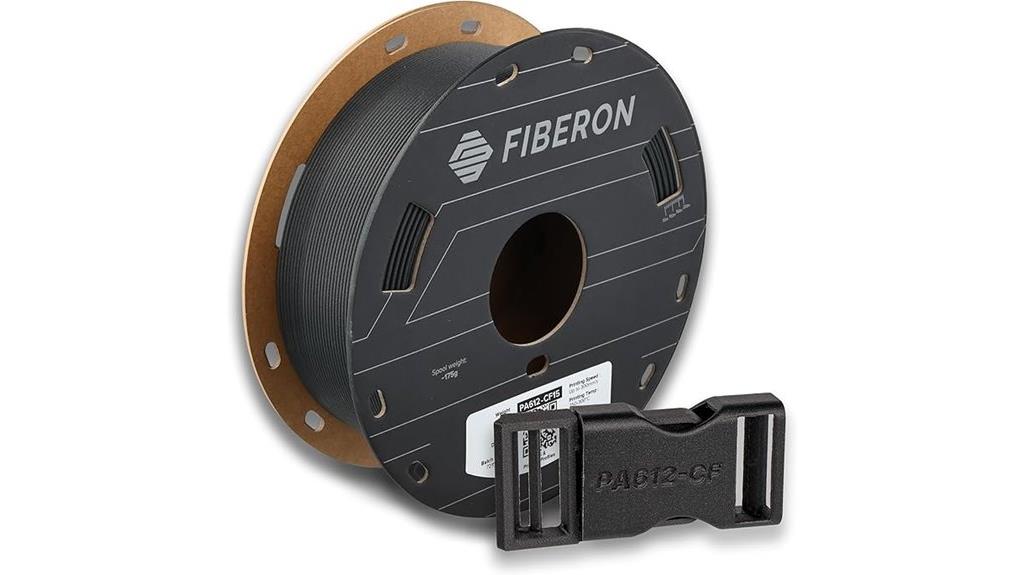
Polymaker Fiberon PA612-CF Carbon Fiber Nylon 3D Printing Filament delivers exceptional mechanical properties for users seeking industrial-grade performance without requiring specialized equipment. This 1.75mm carbon fiber-reinforced nylon offers superior tensile strength and dimensional stability compared to standard PA12. You’ll experience lower moisture sensitivity than PA6/66 variants while maintaining excellent printability.
The filament requires printing temperatures around 70°C with heated bed and PEI surface for maximum adhesion. You’ll achieve minimal warping and strong layer adhesion when properly calibrated. Exercise caution during post-processing—wear gloves and respirator when sanding due to carbon fiber particles. The 0.5kg spool includes moisture-control packaging.
Best For: Engineers, industrial designers, and advanced makers who need high-strength functional parts with superior dimensional stability for automotive components, tooling, and demanding prototypes using standard 3D printers.
Pros:
- Exceptional mechanical properties with high tensile strength and dimensional stability while maintaining compatibility with entry-level printers
- Lower moisture sensitivity than PA6/66 variants combined with minimal warping and strong layer adhesion when properly calibrated
- Includes moisture-control packaging with desiccant and tangle-free winding for reliable storage and printing consistency
Cons:
- Requires precise temperature control around 70°C and heated bed with PEI surface, demanding careful calibration for successful prints
- Safety concerns during post-processing due to carbon fiber particles requiring protective equipment like gloves and respirators
- Limited to 0.5kg spool size which may be insufficient for larger projects requiring continuous printing
OVERTURE Nylon Filament 1.75mm for 3D Printer (1kg Spool, Black)
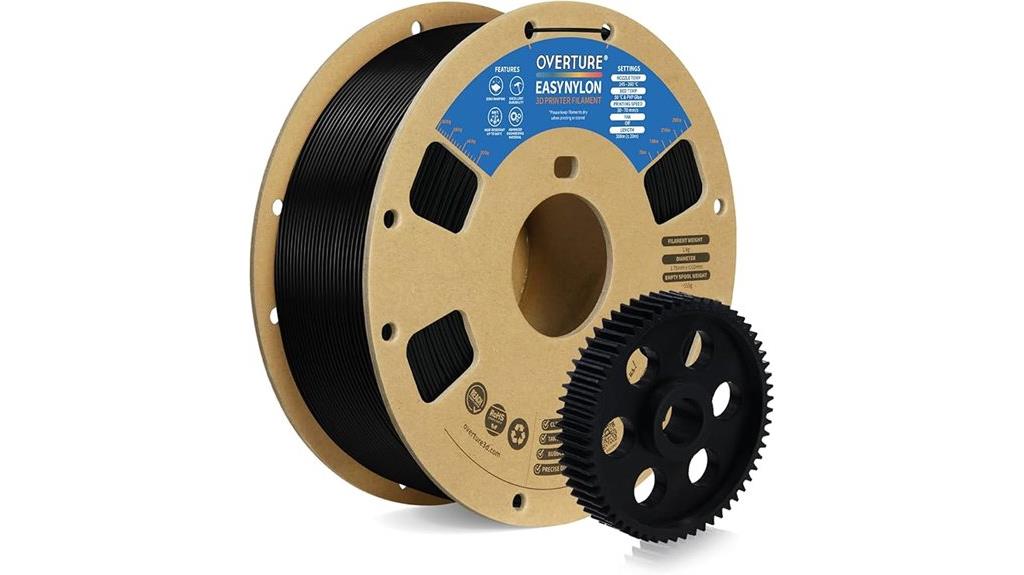
When you need a nylon filament that prints with PLA-like simplicity while delivering engineering-grade strength, OVERTURE’s CoPA nylon filament stands out as the ideal choice for both prototyping professionals and advanced hobbyists.
This filament combines Nylon 6 and Nylon 6.6 for exceptional strength and toughness. You’ll achieve dimensional accuracy within +/- 0.02mm through advanced CCD diameter measuring technology. The material withstands temperatures up to 180°C without warping or producing odors during printing.
You can print using standard PLA settings with just a heated bed and minimal fan cooling. No enclosure or special adhesives are required, making this nylon remarkably user-friendly compared to traditional nylon filaments.
Best For: Prototyping professionals and advanced hobbyists who need engineering-grade strength with PLA-like printing simplicity for functional parts and mechanical components.
Pros:
- Exceptional strength combining Nylon 6 and Nylon 6.6 with high temperature resistance up to 180°C
- Prints easily with standard PLA settings requiring only a heated bed and minimal fan cooling
- Maintains precise dimensional accuracy of +/- 0.02mm with no warping or odors during printing
Cons:
- Limited color options (only available in black)
- May still require slight temperature and retraction adjustments despite PLA-like ease of use
- Higher cost compared to standard PLA filaments for basic printing needs
SUNLU Easy PA Nylon 3D Printer Filament 1.75mm (Black, 1kg)
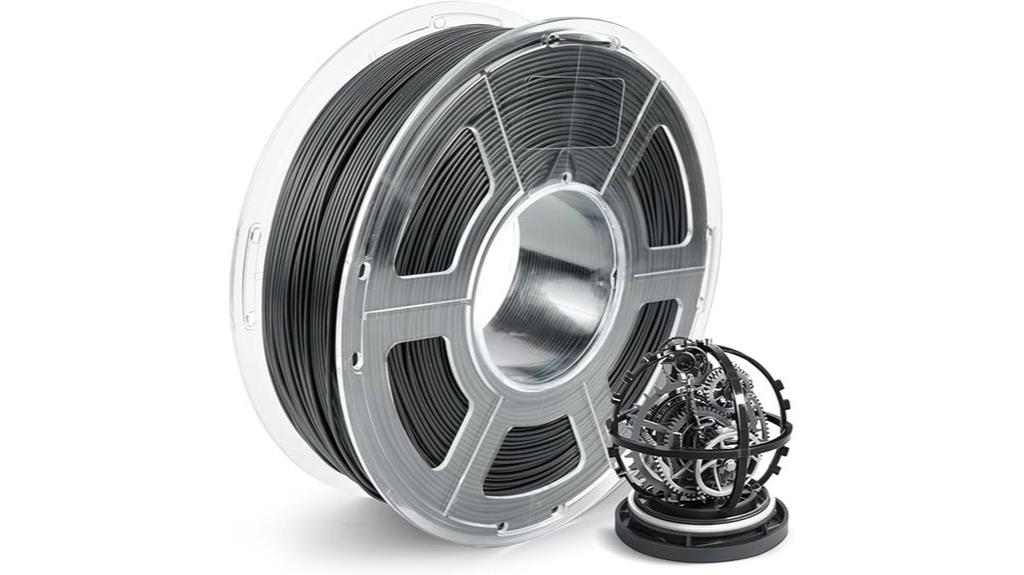
SUNLU Easy PA Nylon delivers exceptional mechanical strength that makes it the top choice for engineers and makers creating functional prototypes, industrial components, and living hinges that demand real-world durability. You’ll get high abrasion resistance and drop-proof toughness that won’t crack under stress. The filament resists heat up to 121°C and handles annealing at 90-130°C for enhanced strength.
You’ll need nozzle temperatures of 250-270°C and bed temperatures of 30-50°C for peak results. Print speeds work well at 60-150 mm/s with minimal warping issues. The low moisture absorption prevents dimensional problems, though you should dry it at 70°C for 48 hours before printing. Strong bed adhesion eliminates most adhesion headaches during complex prints.
Best For: Engineers, makers, and professionals who need to create functional prototypes, industrial components, and living hinges that require exceptional mechanical strength and real-world durability.
Pros:
- Exceptional mechanical properties with high abrasion resistance and drop-proof toughness that won’t crack under stress
- Heat resistant up to 121°C with annealing capability at 90-130°C for enhanced strength in high-temperature applications
- Low moisture absorption prevents dimensional problems and provides strong bed adhesion with minimal warping issues
Cons:
- Requires high printing temperatures (250-270°C nozzle) which may not be compatible with all FDM printers
- Needs 48-hour drying time at 70°C before printing, adding preparation time to projects
- May require adjustments for shrinkage and trial with volumetric flow settings to achieve correct dimensions
IEMAI Carbon Fiber Nylon Filament 1.75mm (PA6-CF 1kg Spool)
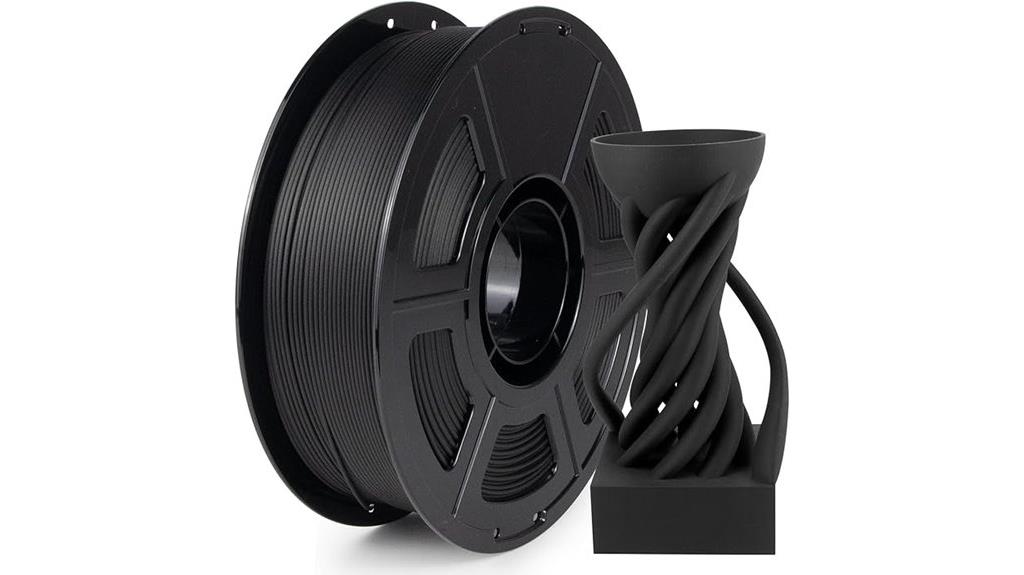
Professional makers and engineers seeking to produce high-performance functional parts will find the IEMAI Carbon Fiber Nylon Filament 1.75mm (PA6-CF 1kg Spool) delivers exceptional mechanical properties through its 20% carbon fiber reinforcement blend. You’ll achieve superior hardness, rigidity, and heat resistance up to 150℃. The filament maintains tight tolerances at +/- 0.02mm with only 0.1% water absorption. Print temperatures range from 260-300℃ with recommended speeds of 30-60mm/s. You’ll need a heated bed at 80-100℃ and a 0.6mm stainless steel nozzle. Users report excellent dimensional accuracy and strong layer adhesion for automotive and aerospace applications.
Best For: Professional makers, engineers, and advanced 3D printing enthusiasts who need high-performance functional parts for automotive, aerospace, or industrial applications requiring superior strength, heat resistance, and dimensional accuracy.
Pros:
- Exceptional mechanical properties with 20% carbon fiber reinforcement providing superior hardness, rigidity, and heat resistance up to 150℃
- Excellent dimensional accuracy with tight tolerances of +/- 0.02mm and strong layer adhesion for reliable functional parts
- Machine-wound with quality inspection ensuring clog-free printing and smooth filament feeding
Cons:
- Requires specialized printing setup including high temperatures (260-300℃), heated bed, and stainless steel nozzle of 0.6mm or larger
- Some users report occasional clogging issues and variability in strength between different batches
- Limited to slower print speeds (30-60mm/s) and requires proper drying and temperature control for optimal results
SUNLU PA6-GF 3D Filament 1.75mm 1KG (25% Glass Fiber Nylon)
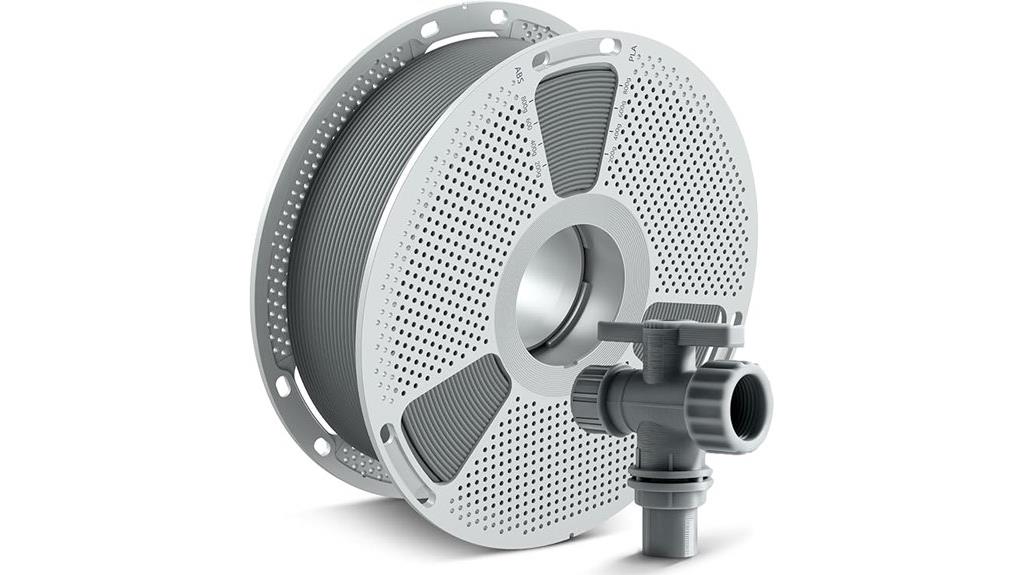
Glass fiber reinforcement transforms standard PA6 nylon into an engineering-grade material that tackles demanding industrial applications where pure thermoplastics fall short. SUNLU’s PA6-GF delivers 25% glass fiber content in precise 1.75mm diameter with ±0.02mm accuracy. You’ll achieve heat resistance up to 417°F while maintaining excellent chemical resistance against harsh acids and industrial solvents.
Print at 270-290°C nozzle temperature with 50-70°C bed temperature for ideal adhesion. The glass fibers provide exceptional impact resistance and dimensional stability, making it ideal for automotive prototypes and aerospace components. Dry the filament at 70°C for 8-12 hours before printing to prevent moisture-related defects. Consider using nozzles larger than 0.4mm to prevent clogging from glass particles.
Best For: Engineers, manufacturers, and advanced 3D printing enthusiasts who need high-strength, chemically resistant parts for automotive, aerospace, industrial, or electronics applications where standard plastics can’t withstand harsh environments or mechanical stress.
Pros:
- Exceptional mechanical properties with 25% glass fiber reinforcement providing superior impact resistance and dimensional stability compared to standard nylon
- Outstanding chemical resistance to harsh acids, fuels, and industrial solvents with heat resistance up to 417°F (214°C)
- Precise dimensional accuracy of ±0.02mm with good value pricing for engineering-grade filled nylon filament
Cons:
- Requires high printing temperatures (270-290°C) and mandatory drying process (8-12 hours at 70°C) which complicates the printing workflow
- Glass fibers can clog standard 0.4mm nozzles, requiring larger diameter nozzles and potentially causing increased nozzle wear
- Some users report inconsistent filament diameter and occasional printing difficulties despite following recommended settings
YXPOLYER 3D Printer Nylon Filament PA6 1.75mm (White, 1kg)
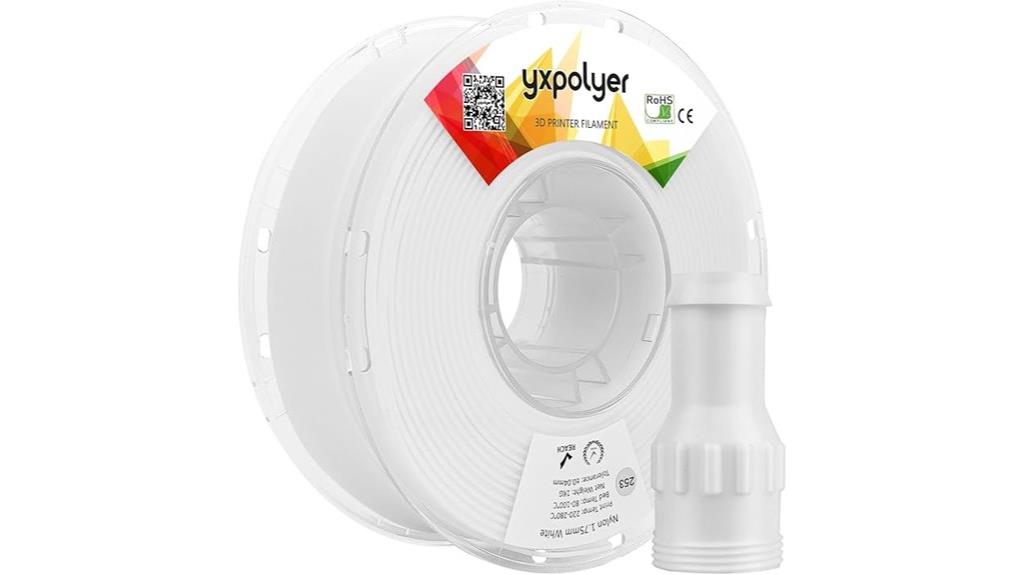
YXPOLYER’s PA6 nylon filament delivers exceptional impact strength that’s over 10 times greater than standard PLA, making it the ideal choice for engineers and makers who need durable functional parts that won’t fail under stress.
This 1.75mm filament excels in fatigue resistance, perfect for hinges and springs requiring repeated flexing. You’ll appreciate its superior abrasion resistance for gears and bearings, plus excellent chemical resistance against oils and solvents. The material handles temperatures up to 381°F.
However, you’ll need proper preparation. Dry the filament before printing and use a heated enclosure to minimize warping. Larger prints pose challenges, so consider keeping parts smaller. Despite occasional stringing issues, this affordable nylon offers factory-like finish quality when settings are optimized correctly.
Best For: Engineers and makers who need durable functional parts like hinges, gears, and bearings that can withstand high stress, repeated flexing, and exposure to oils or solvents.
Pros:
- Exceptional impact strength over 10 times greater than PLA with superior fatigue and abrasion resistance
- High temperature tolerance up to 381°F with excellent chemical resistance against oils, greases, and solvents
- Affordable pricing compared to other nylon brands while delivering factory-like finish quality when properly configured
Cons:
- Requires significant preparation including mandatory drying and heated enclosure to prevent warping issues
- Limited to smaller parts as larger prints are prone to warping even with optimal settings
- More prone to stringing compared to other nylon filaments under similar printing conditions
Kingroon Nylon 3D Printer Filament, 1.75mm, Black (1kg Spool)
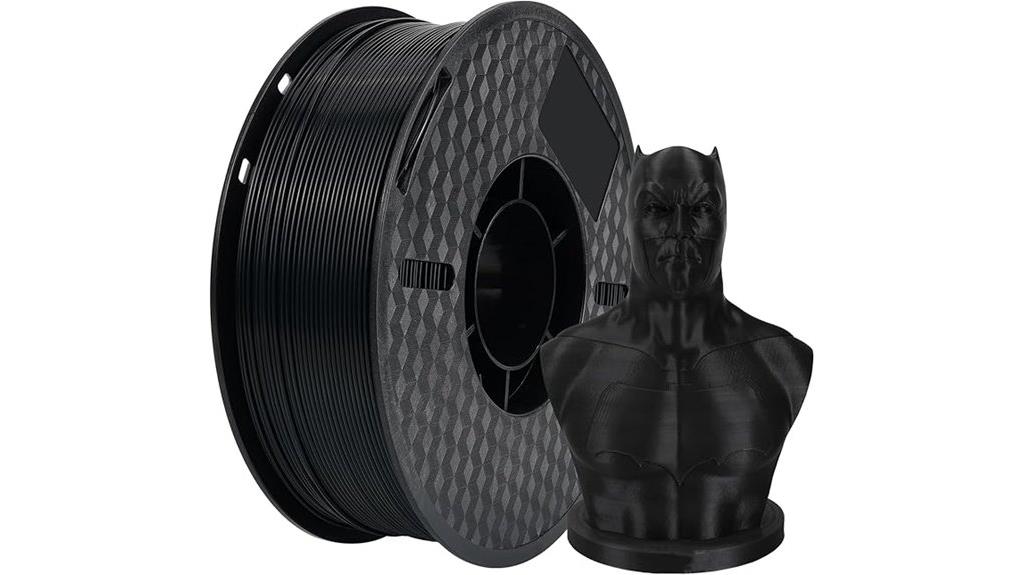
The Kingroon Nylon 3D Printer Filament delivers exceptional durability for engineers and makers demanding high-performance prints that withstand heat and impact stress. You’ll get dimensional accuracy within ±0.03mm on this 1.75mm black filament. The material melts at 185°C and offers superior mechanical properties for creating durable components with glossy finishes.
You should heat your bed to 90-110°C and apply PVA glue stick for ideal adhesion. The vacuum-sealed packaging includes desiccant to prevent moisture absorption. This filament works reliably with various printers, including the Ender 3 v2, though you may need calibration adjustments. Customer feedback shows 4.3-star ratings from over 1,000 users who praise its consistent print quality and reliability.
Best For: Engineers, makers, and 3D printing enthusiasts who need high-performance filament for creating durable parts that can withstand heat and impact stress with professional-grade dimensional accuracy.
Pros:
- Excellent dimensional accuracy of ±0.03mm with high heat and impact resistance for durable applications
- Vacuum-sealed packaging with desiccant prevents moisture absorption and extends shelf life
- Compatible with various 3D printers and produces glossy surface finishes with reliable print quality
Cons:
- Requires higher bed temperatures (90-110°C) and PVA glue stick application for proper adhesion
- May need printer calibration adjustments and pre-drying in humid climates for optimal results
- Some users report occasional tangling issues and inconsistent color outcomes after printing
Siraya Tech Fibreheart PPA 3D Printing Filament – High Performance Polyphthalamide Nylon (1kg, 1.75mm)
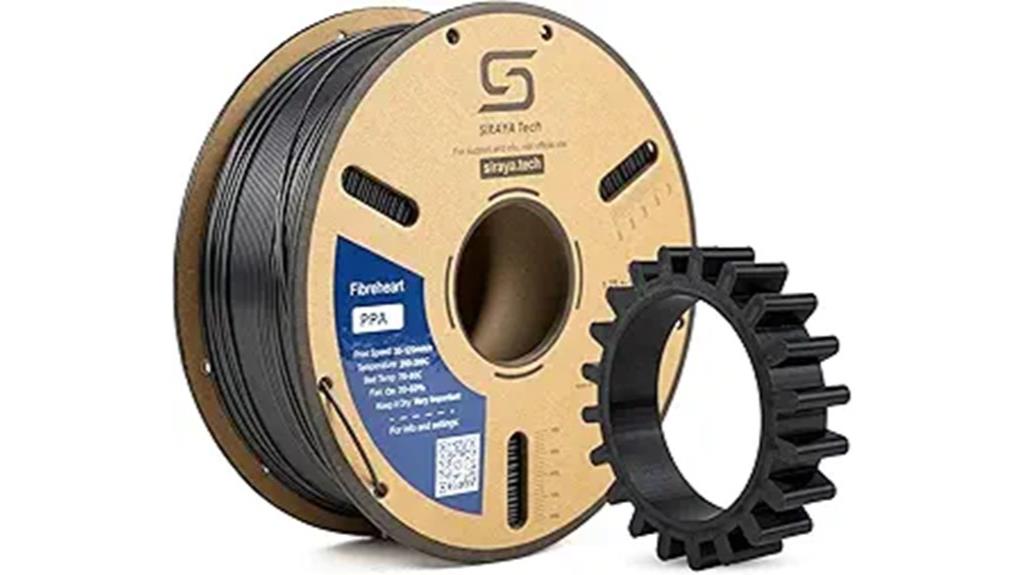
Siraya Tech Fibreheart PPA filament delivers exceptional performance when your projects demand materials that can withstand aggressive chemicals, high temperatures, and extreme mechanical stress. This polyphthalamide nylon achieves 70 MPa tensile strength and 114 MPa flexural strength while maintaining low water absorption at just 2.50%. You’ll find its moisture resistance approximately five times better than PA6 nylon. The self-lubricating properties and low friction coefficient make it ideal for gears, bearings, and high-stress components. However, you’ll need precise print settings and proper drying techniques. Customer reviews show mixed results, with some experiencing adhesion and shrinkage challenges despite the material’s superior mechanical properties.
Best For: Engineers and manufacturers creating functional prototypes, automotive/aerospace components, gears, bearings, and high-stress parts that require superior chemical resistance, high-temperature performance, and exceptional mechanical strength.
Pros:
- Exceptional mechanical properties with 70 MPa tensile strength and 114 MPa flexural strength, significantly outperforming traditional nylons
- Superior moisture resistance with water absorption approximately five times better than PA6 nylon at only 2.50%
- Self-lubricating properties and low friction coefficient make it ideal for moving parts like gears and bearings
Cons:
- Requires precise print settings and proper drying techniques, making it challenging for beginners
- Mixed customer reviews report adhesion and shrinkage issues during printing
- Inconsistent guidance between packaging instructions and website recommendations for optimal settings
Factors to Consider When Choosing Nylon Filament
When I’m selecting nylon filament for your projects, I evaluate five critical factors that directly impact print success and final part performance. Material composition determines whether you’re working with pure nylon 6, nylon 6/6, or reinforced variants like glass-filled composites that offer 2-3x higher tensile strength but require heated chambers reaching 80-100°C. You’ll need to match temperature requirements with your printer’s capabilities, assess moisture sensitivity levels since nylon absorbs 2-9% water by weight, understand mechanical strength properties for your application, and guarantee proper print bed adhesion through surface preparation or specialized adhesion solutions.
Material Composition Types
Composition variants notably impact nylon filament performance, with each type offering distinct mechanical properties and application advantages. PA6 provides superior toughness as the foundation material. I recommend glass fiber-reinforced nylon like PA6-GF for enhanced durability. This variant incorporates approximately 25% glass fibers, delivering improved impact resistance and reduced moisture absorption compared to standard nylon.
Carbon fiber-reinforced options such as PA612-CF offer heightened tensile strength and dimensional stability for industrial applications. Mixed compositions like CoPA combine different nylon variants, including Nylon 6 and Nylon 6.6, producing filaments with high durability and zero warping characteristics.
Heat resistance varies markedly across compositions. Some nylon variants withstand temperatures exceeding 400°F (204°C), making them suitable for high-stress applications requiring thermal stability.
Temperature Requirements
Understanding thermal requirements becomes paramount once you’ve selected your nylon composition variant. I’ll focus on three critical temperature zones that determine print success.
Your extruder temperature should range from 185°C to 194°C, depending on your specific nylon type. Exceeding these limits causes filament degradation, while insufficient heat creates poor layer adhesion.
Set your heated bed between 50°C and 110°C. This range prevents warping and guarantees proper first-layer adhesion. I recommend starting at 80°C and adjusting based on your results.
High-temperature variants like PA6 withstand prolonged exposure up to 150°C. You can anneal these prints at 90-130°C to enhance strength considerably.
Precise thermal control isn’t optional—it’s crucial for achieving professional-grade results in demanding applications.
Moisture Sensitivity Levels
Although temperature control forms the foundation of successful nylon printing, moisture management presents an equally critical challenge that’ll make or break your project. Nylon filaments absorb moisture from the environment due to their inherently hygroscopic nature. Standard PA6-based filaments can absorb up to 0.1% water content, causing warping, stringing, and poor layer adhesion during printing.
I’ve found that reinforced variants with carbon fiber or glass fiber content up to 25% show notably lower moisture sensitivity. These materials maintain better dimensional stability compared to pure nylon formulations. Proper drying becomes essential before printing. I recommend drying nylon filaments at 70°C for 24 hours minimum to achieve peak performance. Without adequate moisture control, you’ll experience increased warping and dimensional inaccuracies that compromise your final print quality.
Mechanical Strength Properties
When selecting nylon filament for demanding applications, mechanical strength properties become the decisive factor that separates functional prototypes from production-ready components. I’ve found that nylon PA6 delivers over 10 times the toughness of PLA, making it essential for high-stress parts. Reinforced variants with carbon or glass fiber offer dramatically enhanced tensile strength and impact resistance.
The high fatigue resistance proves critical for cyclic loading applications. I recommend nylon for hinges and springs where repeated stress cycles would destroy other materials. The melting temperature reaches 381°F (194°C), providing superior heat resistance compared to standard thermoplastics.
Low friction coefficient and exceptional abrasion resistance make nylon perfect for dynamic components like gears and bearings where material durability determines operational lifespan.
Print Bed Adhesion
Print bed adhesion represents the make-or-break factor that determines whether your nylon print succeeds or becomes an expensive failure. Nylon’s tendency to warp, particularly on larger parts, demands strategic preparation. I recommend maintaining bed temperatures between 50°C to 110°C for ideal stability and delamination prevention.
PVA-based glue sticks enhance surface grip considerably. Your printer surface must handle nylon’s aggressive adhesion characteristics without damage during removal. A heated chamber or enclosure provides consistent ambient temperatures, eliminating warping from temperature fluctuations.
First layer settings require careful calibration. Adjust print speeds slower and nozzle temperatures higher than standard settings. These modifications guarantee proper material flow and surface bonding. Without proper bed adhesion, even premium nylon filaments will fail catastrophically mid-print.
Warping Resistance Characteristics
Understanding warping resistance becomes critical since nylon’s molecular structure creates inherent thermal stress during cooling phases. I’ve observed that nylon’s 381°F melting temperature creates considerable dimensional instability without proper thermal management.
Different formulations exhibit varying warping characteristics. PA12 typically shows superior resistance compared to PA6 due to lower moisture absorption rates. Reinforced varieties with glass or carbon fiber additives demonstrate enhanced stability during cooling cycles.
I recommend heated chambers to maintain consistent ambient temperatures throughout printing. Glass or garolite build plates improve adhesion considerably over standard surfaces. Thick brims and increased bottom layer counts distribute thermal stress more effectively.
Moisture control proves essential since absorbed water creates steam bubbles during extrusion, weakening layer bonds and increasing warping probability. Proper filament drying eliminates this contributing factor entirely.
Application Specific Needs
Selecting the right nylon filament requires matching material properties to your specific application demands. I’ll evaluate tensile strength and impact resistance first. These properties vary dramatically between nylon types, directly affecting structural component performance. For high-temperature applications, I need materials withstanding over 200°C without deformation. Heat resistance becomes critical in automotive or industrial uses.
Moisture sensitivity impacts print quality considerably. Some nylons absorb more humidity than others, affecting dimensional stability in wet environments. Glass or carbon fiber reinforcements enhance rigidity while reducing weight. These composites excel in aerospace and automotive applications requiring superior strength-to-weight ratios.
Layer adhesion and printability characteristics determine success with complex geometries. Different nylon formulations require specific temperature settings, bed adhesion methods, and enclosure requirements for maximal results.
On a final note
I’ve presented eight top-performing nylon filaments with distinct advantages for different applications. Your choice depends on specific project requirements—strength, flexibility, or ease of printing. PA6 variants offer excellent mechanical properties, while carbon fiber reinforced options provide superior rigidity. Consider your printer’s heated bed capabilities and enclosure requirements. These filaments deliver professional-grade results when matched properly to your equipment and technical specifications.





